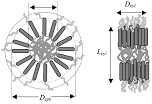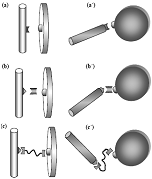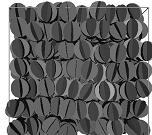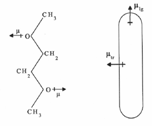A. G. Vanakaras and D. J. Photinos, J. of Mater. Chem., 11(11), 2832-2838 (2001).
 Abstract: A molecular description of the mesomorphic behaviour of globular supermolecules of radial dendritic architecture is presented. It is based on coarse grained structural and conformational features, namely, anisometry of the overall shape, submolecular partitioning of the interactions and non-convexity of the supermolecular surface. The relevance of these features to conformational phase transitions, orientational ordering, layering and microsegregation phenomena in ordered fluid phases is studied using density functional theory of deformable bodies and Monte Carlo simulations of rigid fan molecules. Orientationally ordered and layered phases are found, both in theory and simulation, even in the absence of significant overall shape anisometry.
Abstract: A molecular description of the mesomorphic behaviour of globular supermolecules of radial dendritic architecture is presented. It is based on coarse grained structural and conformational features, namely, anisometry of the overall shape, submolecular partitioning of the interactions and non-convexity of the supermolecular surface. The relevance of these features to conformational phase transitions, orientational ordering, layering and microsegregation phenomena in ordered fluid phases is studied using density functional theory of deformable bodies and Monte Carlo simulations of rigid fan molecules. Orientationally ordered and layered phases are found, both in theory and simulation, even in the absence of significant overall shape anisometry.
A. G. Vanakaras, A. F. Terzis and D. J. Photinos, Molec.Cryst. Liq. Cryst., 362, 67-78 (2001).
 Abstract: A nematic consisting of rod-like and plate-like molecular species is expected to exhibit phase biaxiality over a range of concentrations. Phase separation, however, prevents the achievement of such concentrations in mixtures of conventional, low molar mass, thermotropic calamitic and discotic mesogens. We present a theoretical study of the molecular requirements for phase biaxiality in three types of rod-plate nematics, namely in (i) binary mixtures of hard rods and discs, (ii) mixtures of rods and discs exhibiting molecular association, either by direct rod-disc interaction or through selective interactions with a third molecular species and (iii) single component systems with interconverting rod-like and plate-like conformations.
Abstract: A nematic consisting of rod-like and plate-like molecular species is expected to exhibit phase biaxiality over a range of concentrations. Phase separation, however, prevents the achievement of such concentrations in mixtures of conventional, low molar mass, thermotropic calamitic and discotic mesogens. We present a theoretical study of the molecular requirements for phase biaxiality in three types of rod-plate nematics, namely in (i) binary mixtures of hard rods and discs, (ii) mixtures of rods and discs exhibiting molecular association, either by direct rod-disc interaction or through selective interactions with a third molecular species and (iii) single component systems with interconverting rod-like and plate-like conformations.
A. G. Vanakaras and D.J. Photinos,
Chem. Phys. Lett.,
341(1-2), 129-134 (2001).
 Abstract: We have used Monte Carlo (MC) NPT computer simulations to study a system of spherical-fan-shaped particles made of three hard discs fused along a common diameter. The calculated equation of state indicates a strong, entropy driven. first-order transition from the isotropic phase to a layered phase that has the basic characteristics of the usual smectic-A mesophase but with strongly correlated rotations about the symmetry axes of neighbouring molecules.
Abstract: We have used Monte Carlo (MC) NPT computer simulations to study a system of spherical-fan-shaped particles made of three hard discs fused along a common diameter. The calculated equation of state indicates a strong, entropy driven. first-order transition from the isotropic phase to a layered phase that has the basic characteristics of the usual smectic-A mesophase but with strongly correlated rotations about the symmetry axes of neighbouring molecules.
A. F. Terzis, A. G. Vanakaras and D.J. Photinos,
Molec.Cryst. Liq. Cryst.,
352, 699-708 (2000).
Abstract: We investigate theoretically the liquid crystalline phase behaviour of globular dendrimers consisting of a soft inner scaffold and peripheral mesogenic units attached to the scaffold by means of flexible chains. We use a generalised Onsager molecular theory to analyse model systems exhibiting conformational rod-sphere and rod-disc interconversions. Phase transitions normally not encountered in low molar mass mesogens are reported. For a system with spherical lowest energy conformation a thermotropic re-entrance to the isotropic phase is observed.
A. F. Terzis, A. G. Vanakaras and D.J. Photinos, Molec.Cryst. Liq. Cryst., 330, 1761-1768 (1999).
 Abstract: We present a simple statistical theory of anisotropic fluid phases consisting of deformable molecules and we use it to describe the self-organization of liquid crystalline dendrimers in the limit of very densely attached mesogenic units. We perform calculations for model-systems of spherical molecules that can deform into rod-like or disc-like states and we determine their mesomorphic range as a function of molecular shape parameters and intrinsic conformational probability.
Abstract: We present a simple statistical theory of anisotropic fluid phases consisting of deformable molecules and we use it to describe the self-organization of liquid crystalline dendrimers in the limit of very densely attached mesogenic units. We perform calculations for model-systems of spherical molecules that can deform into rod-like or disc-like states and we determine their mesomorphic range as a function of molecular shape parameters and intrinsic conformational probability.
A. G. Vanakaras and D.J. Photinos, Molec.Cryst. Liq. Cryst., 262, 463-471 (1995).
 Abstract: We formulate the probability distribution of orientations and conformations of flexible chains by explicitly taking into account short range repulsions and el ectrostatic interactions with the solvent molecules. The theory is used calculate the segmental order parameters associated with proton NMR measurements on n-alkanes and to study the apparent shift of the gauche-trans energy in the nematic phase. The foundation of the modular description of chain ordering is investigated in the light of the above developments. Excluded volume and electrostatic effects on the conformation energy of dimethoxyethane are evaluated.
Abstract: We formulate the probability distribution of orientations and conformations of flexible chains by explicitly taking into account short range repulsions and el ectrostatic interactions with the solvent molecules. The theory is used calculate the segmental order parameters associated with proton NMR measurements on n-alkanes and to study the apparent shift of the gauche-trans energy in the nematic phase. The foundation of the modular description of chain ordering is investigated in the light of the above developments. Excluded volume and electrostatic effects on the conformation energy of dimethoxyethane are evaluated.
 Abstract: A molecular description of the mesomorphic behaviour of globular supermolecules of radial dendritic architecture is presented. It is based on coarse grained structural and conformational features, namely, anisometry of the overall shape, submolecular partitioning of the interactions and non-convexity of the supermolecular surface. The relevance of these features to conformational phase transitions, orientational ordering, layering and microsegregation phenomena in ordered fluid phases is studied using density functional theory of deformable bodies and Monte Carlo simulations of rigid fan molecules. Orientationally ordered and layered phases are found, both in theory and simulation, even in the absence of significant overall shape anisometry.
Abstract: A molecular description of the mesomorphic behaviour of globular supermolecules of radial dendritic architecture is presented. It is based on coarse grained structural and conformational features, namely, anisometry of the overall shape, submolecular partitioning of the interactions and non-convexity of the supermolecular surface. The relevance of these features to conformational phase transitions, orientational ordering, layering and microsegregation phenomena in ordered fluid phases is studied using density functional theory of deformable bodies and Monte Carlo simulations of rigid fan molecules. Orientationally ordered and layered phases are found, both in theory and simulation, even in the absence of significant overall shape anisometry.


